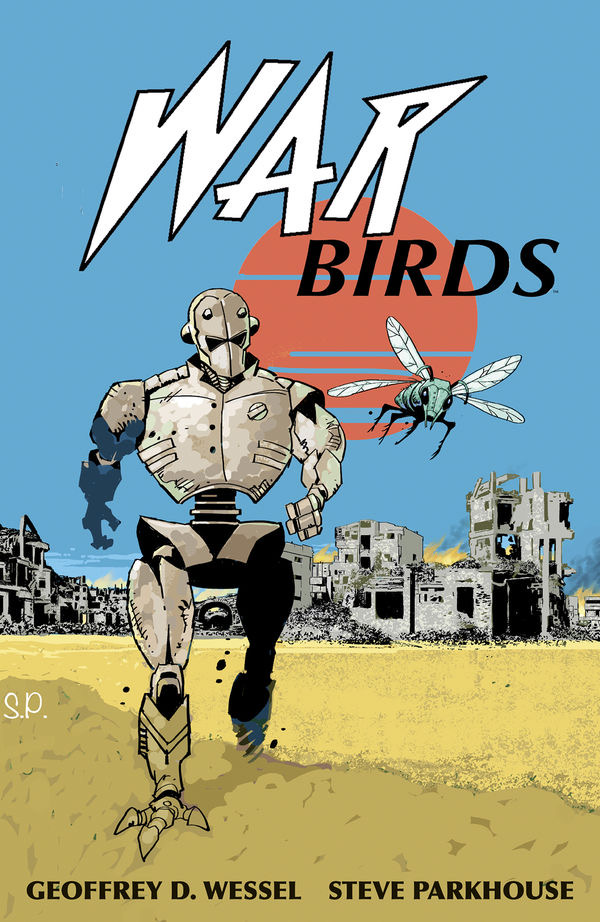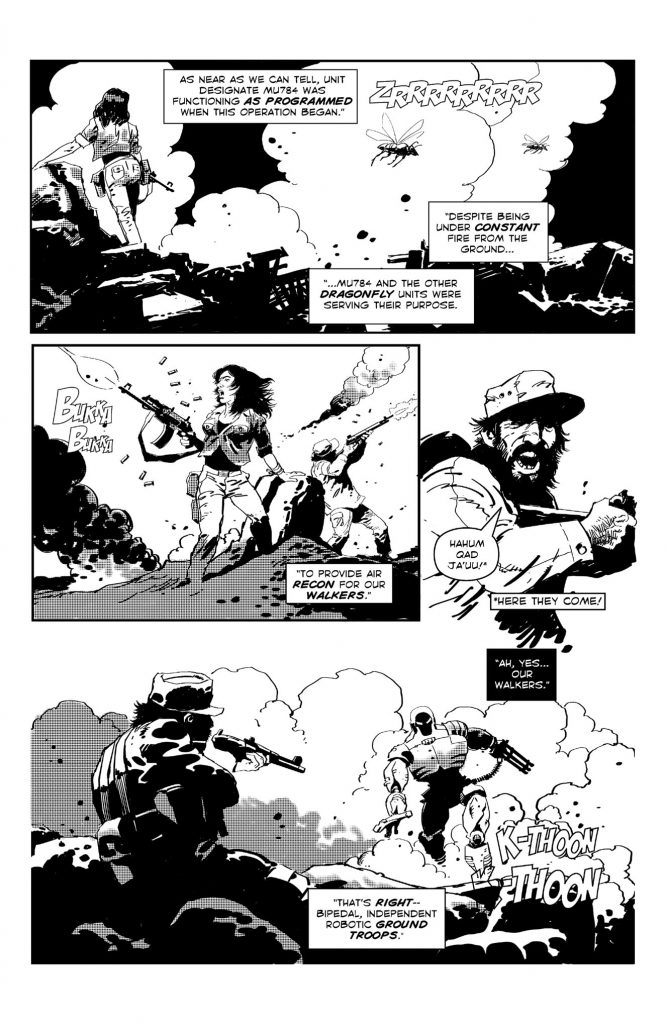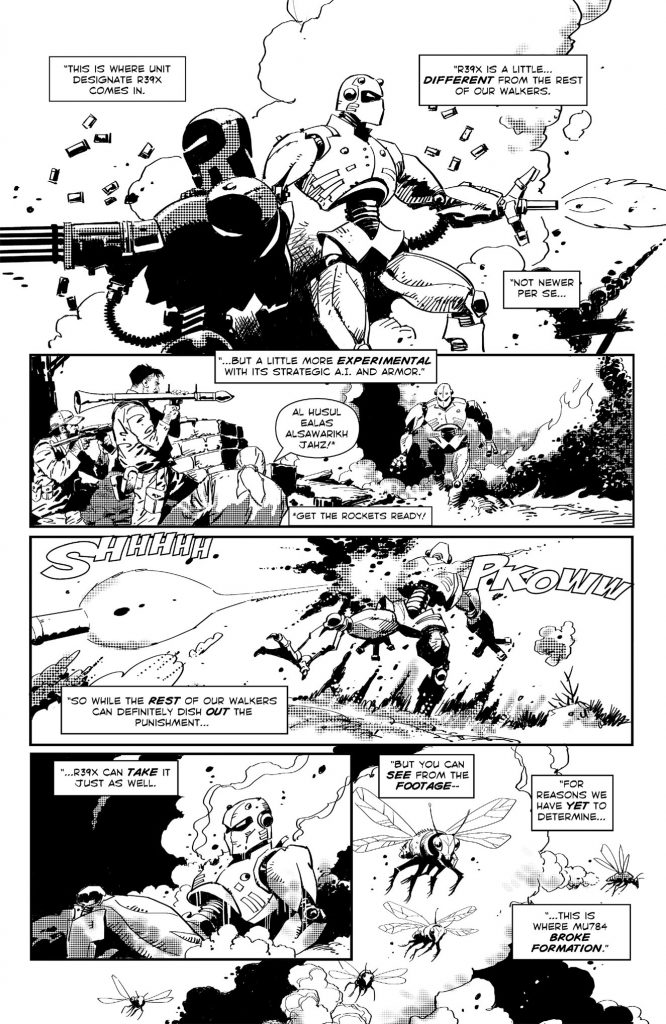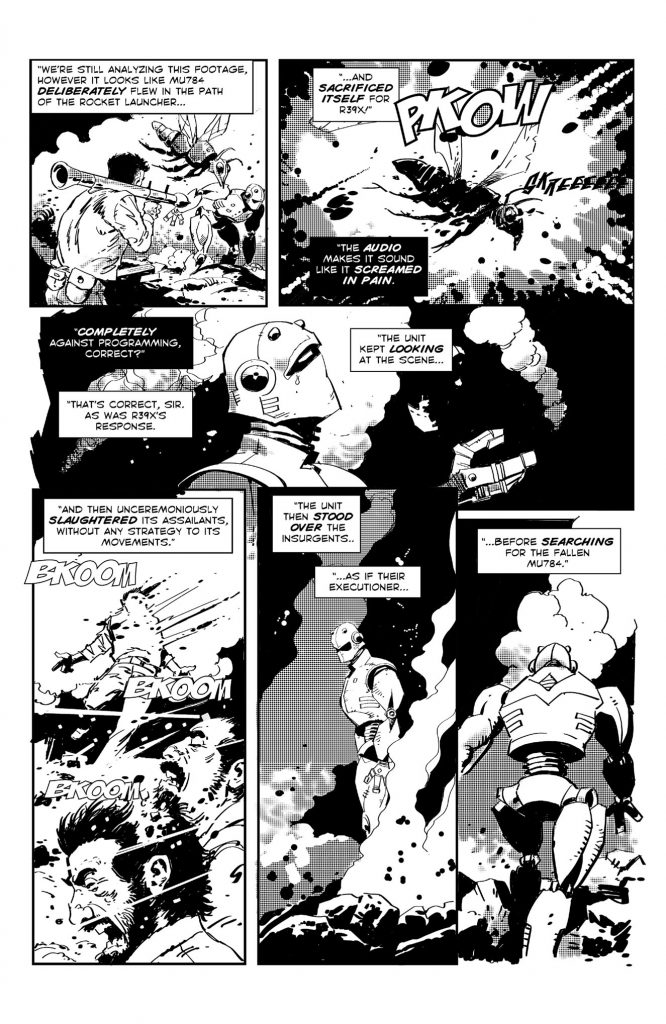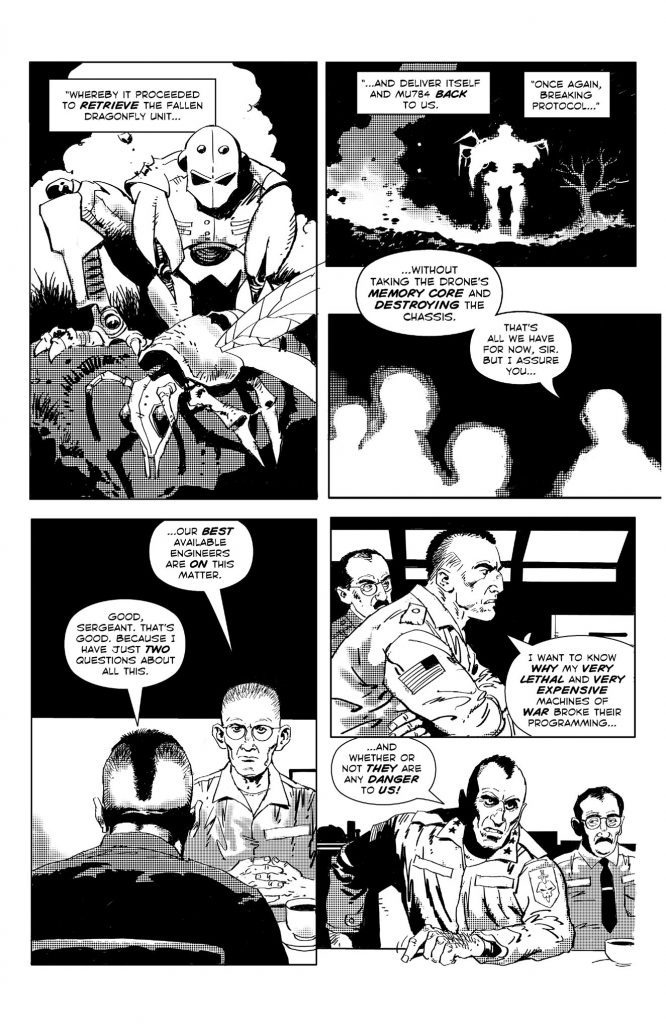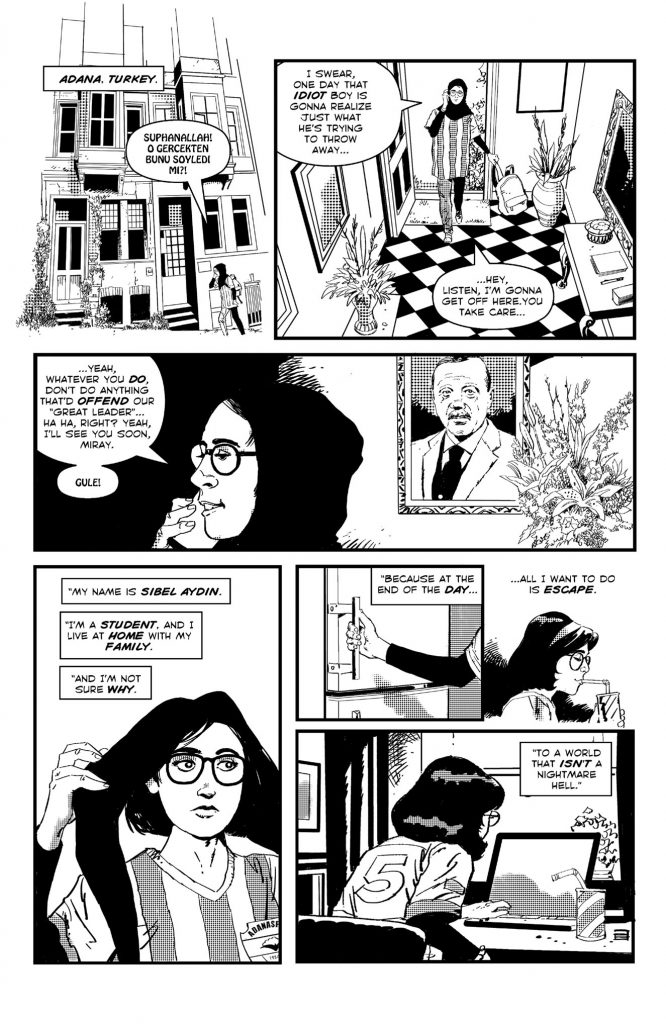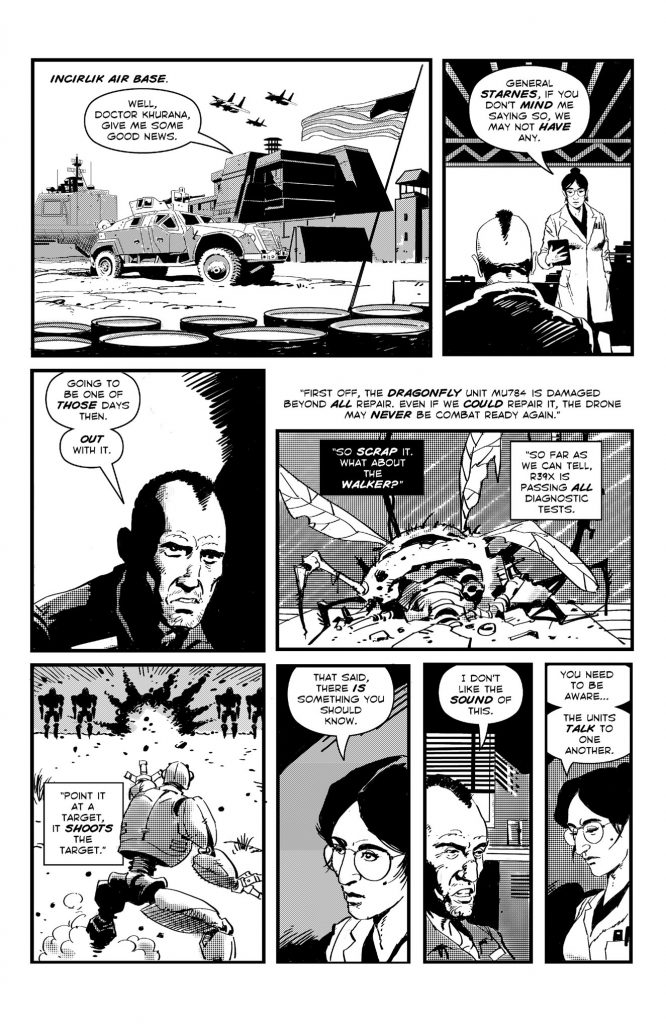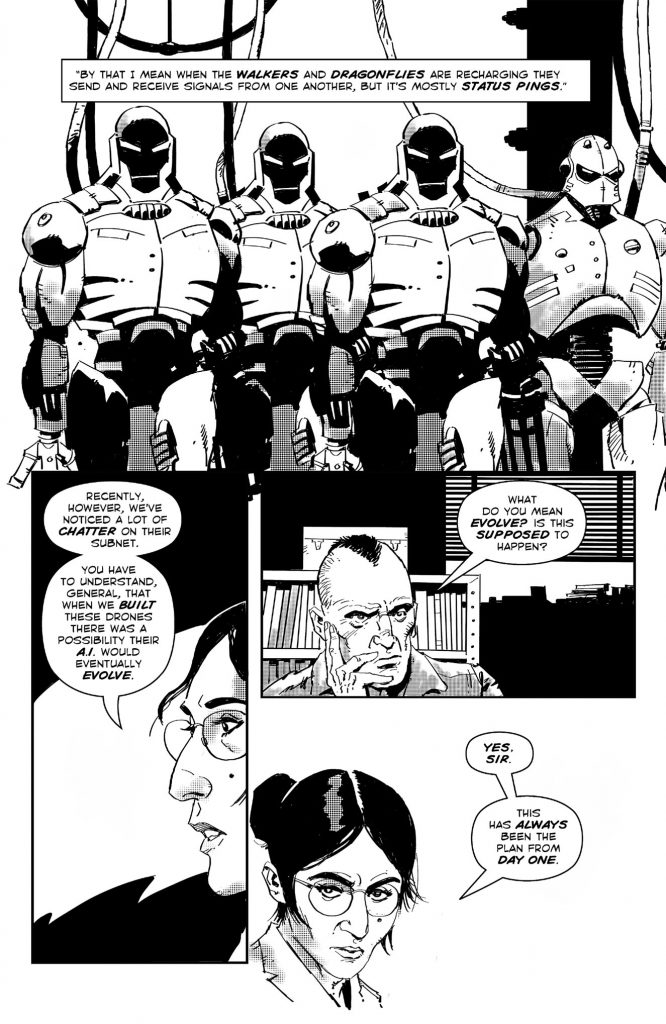When focusing on the topic of Artificial Intelligence, speculative science fiction has a long tradition of positing what humans’ relationship with A.I. would look like. Would we work hand in hand with A.I. and robots–or would we subjugate them for our own ends? And how would robots react to this enslavement? What if they fought their programming?
These questions and more are the focus of Dark Horse Comics‘ graphic novel War Birds from writer Geoffrey D. Wessel and artist Steve Parkhouse, available in trade paperback later this month. In War Birds, a bipedal robot and a flying drone manage to cast off their military programming for destruction, becoming devoted to one another even as their military masters seek to retrieve and terminate them. War Birds prods the reader with questions and invites them to ponder those questions, while at the same time draws you in with a tale of friendship and love.
Mr. Wessel and Mr. Parkhouse spoke with me recently about the idea behind War Birds, the cast of robots and humans we’ll meet in the story, the influences that impacted the shaping of the comic, and how and why the Endless War will grind us all down if we don’t change our ways of thinking.
FreakSugar: For those who aren’t familiar with the book, what is the concept behind War Birds?
Steve Parkhouse: Well, my understanding is that it’s a story of redemption. Science and technology have limited the definition of intelligence to a very small function, which tends to serve mostly scientists and technicians in their respective careers. You’ve got me started here. I have an aversion to the notion that intelligence is merely a facility for doing sums at high speed. Whereas non-conceptual intelligence is about making a connection with the creative source…whatever you perceive that to be. Nobody could deny that great scientists have expansive imaginations. But most scientists are just out to make a buck. They’ll sell anything to the highest bidder, and in this it’s the military. But in the end we have two scientists who have a change of heart and attempt to redress the balance when they realize that artificial intelligence has evolved into something resembling consciousness. That’s just my view. Geoffrey may have a completely different story.
Geoffrey D. Wessel: Steve pretty much has it there. The story is one of redemption, for many of the characters, coming to grips with a new idea, a change in paradigms, and how they are going to live with it or what they are going to do about it. Things don’t work out for everyone.
FS: The tale centers on a robot soldier and a drone and their friendship in the chaos surrounding them. What can you tell us about the duo?
GDW: Our protagonists are what you said they were. They both break their programming and decide they are tired of the Endless War that is now going to destroy THEM, and decide to make a run for it. Their programming says they are made to destroy, and that includes one another in case they are compromised, and when they choose not to do so, it leads to all sorts of complications for them. They are incredibly devoted to one another but haven’t had the time to figure out why.
FS: What was the inspiration behind your story? Did it come to you whole cloth or in bits here and there?
GDW: The inspiration was a three-word phrase that popped in my head one day, “Drones In Love.” Right around then, I saw a documentary on PBS Frontline called DRONES: REMOTE CONTROL WAR that had a quote from a young man who lives in a target area, proclaiming he lived in fear of a sunny day because that meant a drone strike was possible. That directly inspired a scene in the early part of the story, but it just sort of spiraled from there, including figuring out what “Drones In Love” actually meant. Turns out it was pretty literal! The basic idea came fully formed, but of course storytelling is never as simple as that, and there were bits and pieces we came up with, and added, and altered. It was a very educational process.
FS: There are humans—all with varying motivations—populating the book. What can you tell us about who we’ll meet in the story?
SP: Ah well. You’ll meet my favorite character, who is an avatar of the lead female in a computer game. She doesn’t do much but she’s a vital part of the story’s development and resolution.
GDW: Yeah, Steve is referring to Sibel, the young Turkish Muslim woman who is our human lead, who receives a random cry for help in her video game. She recruits her brother, Berat, into this scheme. They have very differing reactions to our drones, which I thought was important to show, because they are the ones living in or around the Endless War. Indeed, they live in the nearest city to Incirlik Air Base, where the drones are kept. Of course, that area is now the site of the devastating earthquakes that have hit Turkey and Syria recently, something Steve and I have been horrified over.
Of course, there are also the various military personnel, soldiers and scientists, American and Turkish, all of whom have their own opinions on what the drones are doing, and not all of them positive. There’s a wide array of humanity on display in War Birds.
FS: What has been the collaboration process been like between the two of you?
SP: A little remote. Thousands of miles between us, actually. I couldn’t think of two people more different than Geoffrey and myself. For instance, he supports Arsenal for some outlandish reason, while I support West Ham United, the team that won the World Cup in 1966. Geoffrey speaks American and I speak English. The King’s English no less. Geoffrey doesn’t draw, but I draw all the time. And I mean ALL the time, from the moment I get up in the morning til last thing at night. I’m an artdroid (in joke). This enormous gulf is normal for writer/artist teams. But apart from our differences, we both have an appreciation for Cumberland sausage and the Roman Empire, which is NOT normal for writer/artist teams.
GDW: As Steve casually alludes to, everything between us was over the internet, spawning from a random meeting over social media. That is, until I went and ruined it by showing up in the UK, and Steve foolishly taking me in for a day or two. During this jaunt, I was introduced to two UK delicacies – Cumberland sausage, and Irn Bru. I’ve since been able to find Irn Bru here in Chicago, however Cumberland sausage continues to elude me so I guess I’m going to have to come back sometime. Incidentally, what Steve leaves out is that I gave up a gilded chance of seeing Arsenal play a home Europa League match to visit him, and Arsenal made the Final of that competition that year, only to be thrashed by Chelsea in embarrassing fashion. There’s a lesson here somewhere, but I’ll leave that for the philosophers to figure out.
But you asked about our collaboration process. Basically, we did this Marvel-style, which, if you aren’t aware, is that I wrote a basic idea of what was to happen on the page(s), Steve drew them based on my notes, with his idea of how they should look, and then I write the dialogue and sound-effects to fit what’s on the page. Steve was on board for working this way, saying he found it creatively freeing, and of course, he DID work in the Actual Marvel Bullpen when Actual Stan Lee et al were there, so there’s some history for him there. Mind you, for all you burgeoning writers out there, always ASK your artist if they are OK with working this way, because not all of them are!
Of course, we both had notes and ideas and changes we thought should occur during the creation of the pages, not to mention the interruptions we had because Steve had the gall to co-create a different comic that’s gone on to be a smash hit TV show, but that’s his Day Job, and this was our labor of love side gig. And honestly, it was one of the best projects I’ve ever been a part of and couldn’t be happier to have worked with Steve to make it happen.
FS: There are themes of A.I., how we treat A.I., and war woven throughout the book. If you had a message or messages behind the story, what would they be?
SP: Try and avoid war. And also be wary of any technology that claims to be intelligent. It isn’t. Intelligence has very little to do with calculation. If technology was intelligent it wouldn’t get involved in wars. See above. We’ve been warned that A.I. will replace humanity. It won’t. You can’t replace consciousness. It’s a fundamental factor in the understanding and structure of the universe as a whole, whereas technology is just a new toy.
GDW: It’s one thing to say A.I. isn’t going to replace humanity, but in the last few months especially, there’s a potent and founded fear that AI is going to replace humans as far as the making of art and the writing of stories. But this is all intentional, as we move away from “Art” and “Stories” into the more late-stage capitalist version, “Content.” Indeed, a major science fiction magazine just had to close submissions because it was getting flooded with contributions that were clearly written by AI. Humans will always create art and stories, but they may not be able to always meet the demand of Content, especially as ownerships become more monolithic and profits must reign supreme. AI is just one part of this, of course, and AI are only as intelligent as what they are taught.
But yes, the Endless War will eventually grind down everyone, maybe even the automatons we’ve built to help wage it. However, there is a message of finding humanity in horrible situations, even in the allegedly soulless devices of war, and if they can break their single-purpose programming bending them towards destruction, maybe there’s hope for us too.
FS: Following up on that, what have been your influences in shaping the story?
GDW: Well, the Endless War, of course, and the rise of global fascism was a big factor in the creation of War Birds. Stylistically, 2000AD was a major influence, as I originally saw this as an online serial, five pages per episode. By the time I got with Steve and we took it to Dark Horse, it became a traditional miniseries, and then after negotiations, a full original graphic novel. But also, a lifetime of reading SF stories, and trying to do something a little different than what’s come before.
SP: Difficult to say inasmuch as I was following a script of somebody else’s making. So the influences were internal, shaped by the fact that I’ve never illustrated a war story up until now – and I wanted to see how I would deal with a theme so far outside my comfort zone. Technically I was out on a limb. I actually think that black and white art has served the story quite well. Initially I was hoping for a vintage style that older readers might remember from the days of Wally Wood and those EC science fiction stories. But it was too ambitious to sustain over eighty pages, so I just gave it my best shot. In the end that’s all you can do.
FS: Do you have a final last pitch for potential readers?
GDW: War Birds is eighty pages of a story you may not have read anything like before, with characters you may never have seen or read before, drawn to perfection by a true master of the artform. We think you’ll like it.
SP: The story has a heart. If it didn’t, I would have passed on the opportunity to contribute. It also has a lot of action, with very few talking heads. If you like drones and robots, this is especially for you! If you don’t like drones and robots this story might just change your mind.
The War Birds trade paperback goes on sale Wednesday, March 22nd, from Dark Horse Comics.
From the official trade paperback description:
Two renegade AI minds want to make conversation–not war! When a bipedal, independent robot soldier makes a unique connection with an injured, flying drone, they flee the warzone they’re in to seek lives of their own. Their military builders want to destroy them, while a sympathetic pair of humans tries what they can to free the errant ‘bots from military service! Steve Parkhouse, artist and co-creator of Resident Alien, joins writer Geoffrey D. Wessel in this thrilling tale of friendship and survival!
* Art, grey tones, and lettering by Steve Parkhouse!

